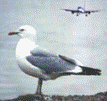Bird Strike Committee Proceedings

Bird Strike Committee-USA/Canada Joint Annual Meeting: 8th (2006)
Date of this Version
August 2006
Document Type
Article
Abstract
We conducted avian evaluations at two Colombian airports to assess, through a standard methodology, the risk of bird strikes. Evaluations were conducted at “Aeropuerto Perales” (AP), Department of Tolima, 1030 m a.s.l. Tropical Dry Forest and, “Aeropuerto Palonegro” (APN), Department of Santander, 1188 m a.s.l. Humid Pre-mountain Forest. Forty-seven species of 12 different families, 3,998 individuals were encountered at AP through 1284 records. In contrast, 33 species of 16 families, 1,112 individuals in 396 records were found at APN. The Whispering ibis (Phimosus infuscatus) was the most abundant species with more than 50% of all individuals followed by the Black vulture (Coragyps atratus) with 18% at AP. The first species represented over 72% of all crosses along most of the runaway, the second 11% crossing in high numbers in some areas. Both species mean flock size was over 5 individuals. Threat categorization showed that this two species are the most highly dangerous for this airport. The Yellow-Hooded blackbird (Agelaius icterocephalus), is of high concern but median risk. Awareness for 12 other species is warranted even thou considered of low risk for Aviation procedures at AP. The Black vulture was the only species categorized as highly dangerous at APN, because of its weight and abundance (50% of all individuals) more than 70% cross the runaway and were found in flocks of over 4 mean individuals, but sometimes in huge flocks of over 40. Two other species, the Orange Chinned parakeet (Brotogeris jugularis) and the Eared dove (Zenaida auriculata), are of main concern and median risk. Five other species are of awareness but low risk following the threat categories at APN. Bird strike evaluation through a standard methodology allows comparing thru ranking priorities the risk, to propose specific and generalized management tools at airports localized in different life zones.

